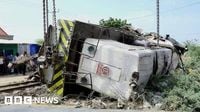On a quiet Monday night in eastern Ethiopia, tragedy struck the Somali region as a packed passenger train derailed and slammed into a stationary freight train, leaving at least 15 people dead and close to 30 more wounded. The crash, which unfolded near the town of Shinile—about 40 kilometers outside the city of Dire Dawa—has sent shockwaves across the country and put a harsh spotlight on the state of Ethiopia’s aging railway infrastructure.
According to BBC Amharic and other local outlets, the ill-fated train was making its way from Dewele, a border town near Djibouti, to Dire Dawa, carrying not only passengers but also a heavy load of goods including rice, pasta, cooking oil, flour, and sugar. Among those on board were many young people and workers, some of whom would not survive the journey. The collision occurred on a downhill stretch of track, where the train met a parked freight lorry loaded with flour and sugar—a detail confirmed by both Borkena and Railway Supply.
The aftermath was chaotic, as described by local officials and eyewitnesses. District commissioner Jibril Omar told BBC Somali that the train’s poor condition and excessive load were major contributors to the disaster. "The cause of the accident appears to be the poor condition of the train, which is very old and unable to handle heavy loads. We believe overloading was a major factor in the crash," Omar explained. He added that most passengers were young people, many of whom managed to survive by leaping from the rolling train moments before impact. "Most of the passengers were young people, many of whom survived by jumping from the train," he said.
Photographs from the scene, published by Dire TV and Railway Supply, show a grim tableau: several carriages overturned, others crushed and twisted along the tracks. Rescue teams worked through the night, extracting survivors and bodies from the wreckage. Emergency workers rushed the wounded to hospitals in Shenele, Dire Dawa, and Addis Ababa. Yet, as the Associated Press reported, the response was hampered by delays—ambulances were not immediately available, forcing locals to pull injured passengers from the mangled carriages themselves.
Mohammed Adem, spokesman for the Somali regional government, confirmed to BBC Amharic and Railway Supply that all deceased and injured passengers had been recovered from the site. The official tally stands at 15 dead and between 27 to 29 injured, though authorities have warned that the number of fatalities may still rise, given the severity of some injuries. Among the dead were workers assigned to the train, underscoring the breadth of the tragedy.
Local leaders moved quickly to express their condolences and address the public’s grief. On Tuesday, Musfata Mohammed, president of the Somali regional state, posted a message on social media mourning the loss. "May Allah give patience and faith to the relatives, relatives and all the civilians of the region that they left. May Allah heal those who are injured," he wrote, as translated by Facebook.
The cause of the crash remains under investigation, but early indications point to a confluence of neglect and operational strain. The train, by most accounts, was an aging relic that had been in service for many years. Mohammed Adem, speaking to BBC Amharic, noted the train had a “motor issue,” though it remains unclear if this was identified before or after the accident. District commissioner Jibril Omar and other officials have pointed to overloading and inadequate maintenance as likely culprits—a sentiment echoed in the reporting by Railway Supply, which cited preliminary investigations implicating both factors.
"Officials indicated preliminary investigations implicate overloading and poor maintenance as key reasons," Railway Supply reported, adding that the train’s dual function as a passenger and freight carrier made it particularly vulnerable. The combination of people and goods, especially on challenging terrain, proved too much for the outdated equipment.
Train accidents are relatively rare in Ethiopia, a nation of over 130 million people where railways are a critical artery for trade and movement—especially in regions like Somali, where ethnic Somalis make up the majority and economic opportunities often hinge on transport links to Djibouti. Yet, as this disaster starkly illustrates, much of the country’s railway infrastructure is in dire need of modernization. While the Addis Ababa–Djibouti corridor has received upgrades, many internal lines are still operated with obsolete rolling stock and suffer from poor maintenance routines.
Eyewitnesses described scenes of panic as the train derailed and passengers smashed windows to escape, while others risked their own safety to pull the wounded from the debris. "Eye-witnesses painted pictures of pandemonium as travelers have smashed windows to escape, and others have yanked maimed individuals from the debris," Railway Supply recounted. The heroism of local residents in the face of adversity has drawn praise, but it has also highlighted the shortcomings in Ethiopia’s emergency preparedness.
In the wake of the crash, government officials have pledged to launch a thorough investigation and take concrete steps to prevent similar tragedies. According to Railway Supply, authorities are now focusing on the urgent need for increased railway vigilance, improved safety inspections, and the modernization of old train equipment. "The government has opened an investigation and plans to strengthen rail safety measures, improve maintenance, and modernize old train equipment to prevent similar incidents," the outlet reported.
The disaster has reignited debate about infrastructure investment and regulatory oversight in Ethiopia. Experts argue that enforcing operational limits, investing in new rolling stock, and conducting regular safety inspections could go a long way toward preventing future accidents. For the communities affected—where trains are lifelines connecting remote towns to economic centers—the tragedy is a painful reminder of the costs of neglect and the pressing need for reform.
As the investigation continues and families mourn their loved ones, the Shinile train crash stands as a somber call to action. Ethiopia’s railways, once symbols of progress and connection, now face a reckoning that demands both transparency and modernization if such heartbreak is to be avoided in the future.


